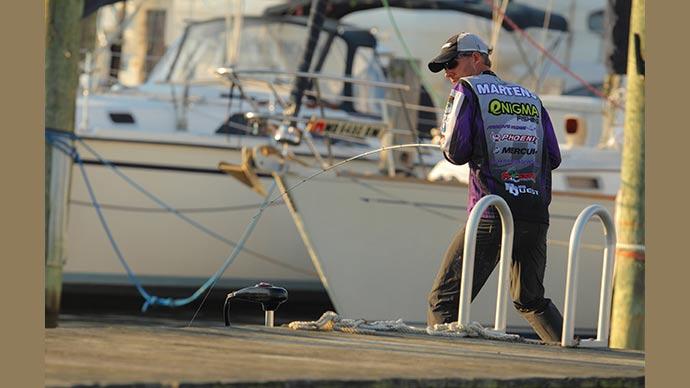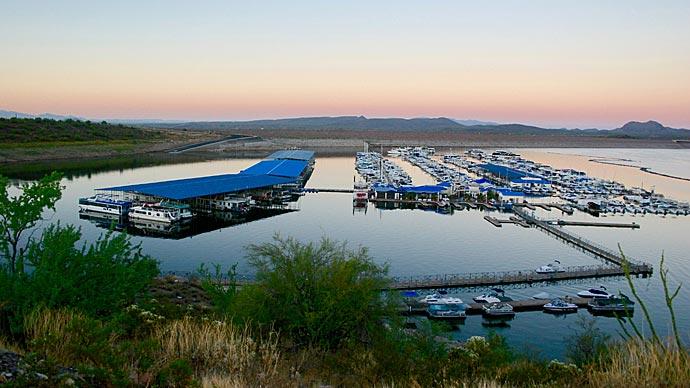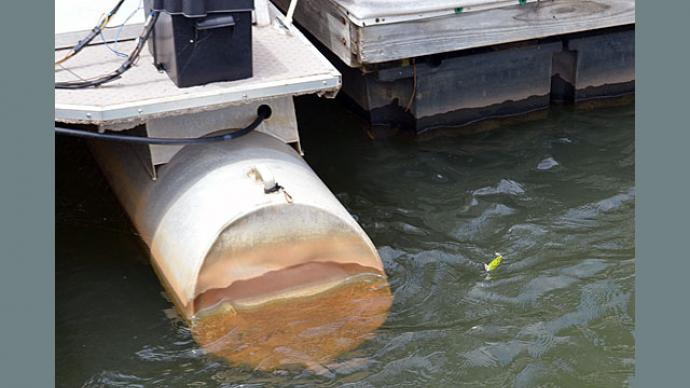
Whether fishing a lake loaded with docks or one lacking boat houses, Dion Hibdon continuously checks out marinas.
The Missouri Pro favors the massive docks of marinas because the docks create plenty of cover for bass. “Marinas hold a lot of food with tons of bluegill and shad,” Hibdon says, “but overall, it is the shade factor (that makes them so good).”
The former Forrest Wood Cup and Bassmaster Classic champion estimates that 50 to 60 percent of the area under marina docks is always in the shade. “That means a lot to a bass,” Hibdon says.
“When bass suspend, there is an endless supply of targets to throw at and fish around.”
Marinas receive less fishing pressure because there is less shoreline for the average angler to fish, and the boat hoists, iron works, and cables make it difficult to reach bass hiding under the docks. “That is where bass want to be - where they don’t get jacked with,” Hibdon says. “That is why there are also better average-size fish there.”
The tournament veteran prefers targeting marinas in the summer and early fall because lots of shad and other forage, such as bluegill and crappie, are active around the massive docks then. Hibdon favors fishing marinas on bright sunny days because it is easier to find bass positioned in the shade of the docks, whereas on cloudy days, bass are harder to find. After all, the fish could be scattered anywhere under the docks.
The length and width of marina docks provide plenty of hiding areas for bass at various depth ranges. So Hibdon tries to find what depth the fish are holding when he starts fishing marinas. “There is so much suspended cover in the marinas that the fish will suspend way more than on regular docks,” Hibdon says.
Corners of the marina docks are easy places to start fishing and are great ambush points for bass. “The corners are the easiest places for you to cast around,” Hibdon says. He also notes that corners of the docks are ideal spots to try on windy days because there will always be one corner of the dock receiving some wind.

Hibdon notes marinas have “cables running everywhere,” and bass often prefer hanging around the cables. Another target for marina bass is the cable anchors resting on the bottom of the lake. “That cable is usually attached to a concrete deal that might be 4 feet by 4 feet square and probably 4 feet tall,” Hibdon says. “That is perfect for a bass. It is like a giant concrete stump on the bottom of the lake.”
A jig is one of Hibdon’s favorite lures for tempting marina bass because he can make the lure imitate bluegill and shad. He favors using jigs in bluegill hues during the summer and models in shad colors in the fall. The size of the jig he selects depends on the depth of the fish. When bass are suspended high in the water column, Hibdon opts for 1/4- or 3/8-ounce jigs but upgrades to 1/2 – to 1-ounce jigs for fishing 18 to 20 feet deep.
Hibdon matches his jig with a flappy trailer that generates a lot of movement. “I want stuff that is flashy,” he says. “I want something that swims a little bit.” Hibdon believes a jig and trailer with plenty of movement will cause suspended bass to chase the lure to the bottom.
Hibdon selects a Senko to tempt suspended bass when he wants a subtle falling lure. He either throws the Senko wacky style or Texas rigged. If he feels the Senko is falling too fast for suspended bass, Hibdon opts for a weightless plastic worm for a slower fall. He also likes to throw a Zoom Fluke around marinas because its body falls horizontally to give the fish a different look than the Senko, which tends to fall head down.
On windy days, bass usually move up in the water column, and outside the marina docks, so Hibdon tempts these fish by swimming a shad-colored jig or a weightless Fluke. “If you are fishing on a day with a lot of wind, and suddenly the wind stops, the Fluke will be more of a subtle presentation than a jig,” he says.
When swimming a jig, Hibdon prefers hopping the lure up and down next to the dock floatation to where it slips in sight and then out of sight of bass suspended under the dock. “You have to consider that the fish is seeing everything,” he says. So Hibdon tries to put his jig in spots where it will be obstructed from the fish’s view for a while, then have it pass by an ambush point for bass to capture it. He will pitch around any boat hoist lowered into the water or a large boat floating inside a dock well because the hoist and boat provide more cover for bass to ambush baitfish swimming in the boat slips.
Marinas are great shelters for boats, but savvy anglers like Dion Hibdon know these giant boathouses are great places to catch fish and quality bass.




